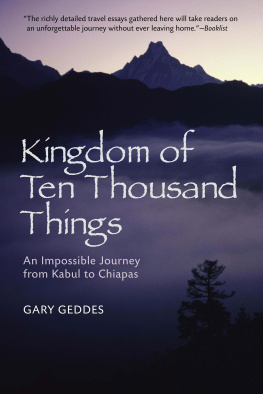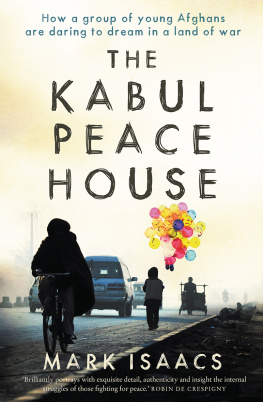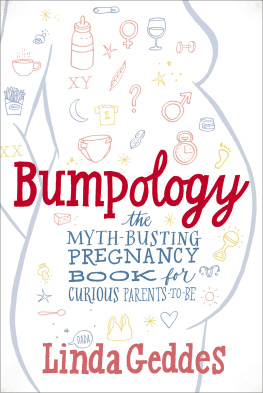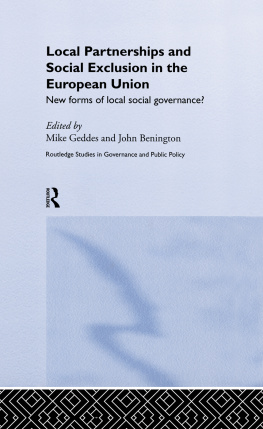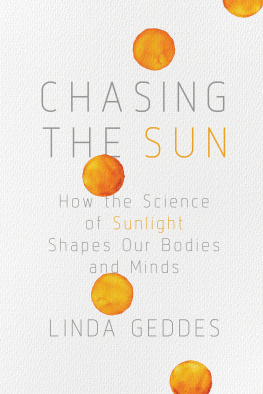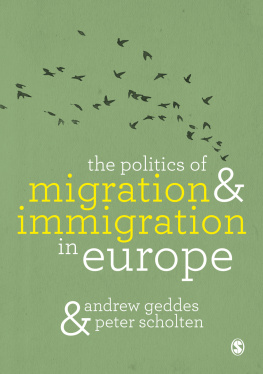ALSO BY GARY GEDDES
POETRY
No Easy Exit
Light of Burning Towers
Girl by the Water
The Perfect Cold Warrior
Active Trading: Selected Poems, 19701995
Flying Blind
Skaldance
FICTION
The Unsettling of the West
NONFICTION
Letters from Managua: Meditations on Politics and Art
Sailing Home: A Journey through Time, Place and Memory
DRAMA
Les maudits anglais
TRANSLATION
I Didnt Notice the Mountain Growing Dark,
poems of Li Bai and Du Fu
CRITICISM
Conrads Later Novels
ANTHOLOGIES
20th-Century Poetry & Poetics
15 Canadian Poets Times 3
The Art of Short Fiction
GARY GEDDES
KINGDOM OF
TEN THOUSAND
THINGS
An Impossible Journey
from Kabul to Chiapas

Kingdom of Ten Thousand Things:
An Impossible Journey from Kabul to Chiapas
STERLING and the distinctive Sterling logo are registered trademarks of
Sterling Publishing Co., Inc.
Library of Congress Cataloging-in-Publication Data Available
2 4 6 8 10 9 7 5 3 1
Previously published by HarperCollins Publishers Ltd.
Published in 2007 by Sterling Publishing Co., Inc.
387 Park Avenue South, New York, N.Y. 10016
2005 by Gary Geddes.
Front cover photography by Shannon Nace/Lonely Planet Images/Getty Images
All Rights Reserved
Sterling ISBN-13: 978-1-4027-4363-4 (hardcover)
Sterling ISBN-13: 978-1-4027-4363-2 (paperback)
Sterling ISBN-13: 978-1-4549-0241-6 (eBook)
For information about customs editions, special sales, premium
and corporate purchases, please contact Sterling Special Sales
Department at 800-805-5489 or specialsales@sterlingpublishing.com.
CONTENTS
KABUL ? Youve got to be kidding. Kim, my local grocer, was brandishing the single banana from my pile of groceries as if it were a revolver about to be aimed at my head.
Yes, Im leaving for Afghanistan. Next week. Then, as a dubious consolation, I added, Via Pakistan.
Kim stepped back, still holding the banana, her other hand resting on the glass cabinet that housed an assortment of doodads for sale, a pink ceramic unicorn with sugary wings, glass candleholders, miniature cloth flower arrangements, and a merry-go-round with three horses that cranked out a syncopated version of the theme from Love Story. Light from the fluorescent tubes on the ceiling fell on Kims long auburn hair, a little gray at the roots, giving her an air of luminosity.
Owner of the French Beach Mini-Mart, less than a mile from my house, Kim was no prude or stay-at-home. As a young woman, she had quit London to see the world, holing up for a spell Down Under. She trained as a dancer, ran a pub, and worked at a variety of jobs before emigrating to Canada. Out here on Vancouver Island, on the edge of the Pacific, where rain is a constant in winter, and fog in summer, and where cougars and black bears frequently cross her gravel parking lot, Kim has eked out a living from a smattering of disorganized hermit-residents like myself and from the seasonal influx of curious tourists heading to Port Renfrew to test their mettle on the West Coast Trail, a suicidal assault course over jagged rocks, slippery moss, rotting logs, and swollen streams on a forlorn but spectacular shoreline known as the Graveyard of the Pacific.
Afghanistan! Kim rolled her eyes and gave me a withering look. Why? She shook her head as she weighed the perishables, then passed the other items in front of the bar-code reader. Although smallan elf with Rapunzel hairshe is not a person to argue with, having chased a black bear out of the store with a rolling pin, its moist snout quivering at the aroma of early-morning pizza and sausage rolls.
Feeling a little perishable myself, I evaded Kims question and its underlying concerns, though she was expressing exactly what family and friends had been telling me for months.
Why not? I replied breezily, stepping through the beam of the newly installed security system and setting off the buzzer. As I turned to wave, I noticed for the first time a poster on the walla doubly whimsical version of the Mona Lisa, her cheek bulging from the chunk of apple she has bitten and is now holding in her lap. The image of Mona Lisa bore an uncanny likeness to Kim.
As I drove home with my groceries, I wondered why I had not given Kim the true story of my attraction to such a volatile part of the world, where Westerners are not exactly welcome and where dust on the horizon heralds yet another invasion. How to explain my thirty-year fascination with a fifth-century Buddhist monk and his epic peregrinations?
Huishenhis original name in Sanskrit is not knownwas a monk from Kabul who fled to China to escape persecution from the Hephthalites, or White Huns, nomads from Central Asia who regularly raided the Afghan area, trashing monasteries and slaughtering the inhabitants. There is no record of his arrival in China. However, he is reported in the Liang Shu, the records of the Liang Dynasty, to have sailed from China to the Americas in AD 458, a distance of twenty thousand li (seven to ten thousand miles), returning in 499 to tell his story to the emperor and the court historian.
My religious education had taught me that forty days and forty nights in the wilderness was an honorable length of time for self-analysis or the testing of ones mettle; forty-plus years was in another league altogether. If such a journey took place, then our assumption that Europeans were the first outsiders to reach the Americasthat is, after the ancient migrationswas badly in need of revision. This possibility appealed to me greatly as a young man; it still does. The arrogance and ethnocentricity of civilization in the Westevident not only in our writing of history, but also in our attitudes toward the rest of the worldcould, it seemed, use a good shaking up.
I was alerted to the story of Huishen in the early 1970s through the writings of historian Harold Griffin, the author of Radical Roots, who gave it a local spin: Whether Hoei Shin actually visited what is now British Columbia is a long-disputed point, but his account of the natives and their customs, particularly their use of the bark of a giant tree for textiles and their extraction of oil from a fish which could only be the eulachon, or candlefish, suggests that he may have. Having grown up on the West Coast, where connections to Asia are very much a part of our consciousness, I was intrigued by this hypothesis. Little is known of Huishens journey. Was it motivated by missionary zeal or by a wise assessment of Chinese politics in which the future of Buddhism was, at best, precarious? Most likely, both. Yet here was a man of courage and faith, setting out into the great unknown to cross a perilous ocean in a small vessel, to risk everything for a dream. As a young boy, I had imagined becoming a missionary and doing the same thing, in the opposite direction. That project, and the faith that fueled it, eventually gave way to the equally rigorous dream of art, a different sort of religion and one that promised as little in terms of money or recognition or success. As a writer, I could identify with the renunciation that surrounded Huishens remarkable journey into the unknown. Over the years, I became the keeper of the tale. It was incorporated into my social repertoire, a story I told so often that one of my friends used parts of it in a book of poems.
As I discovered, I was not alone in my fascination with the idea of Buddhists sailing from Asia to the Americas long before Columbus and how that possibility radically challenged our perspective on the past. Sporadic accounts had been written on the subject, including several books and a spate of newspaper articles and popular essays. One of those essays appeared in a book called
Next page
